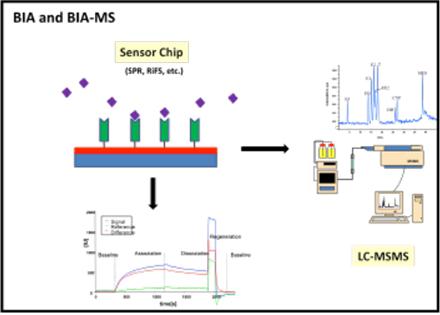The aim of the group Analytical Biochemistry headed by Gerald Brenner-Weiss is to establish analytical tools for detecting specific interactions between receptors and compounds.
Using these analytical tools in a way of a test battery: relevant compounds as well as their transformation products and natural metabolites will be characterized regarding their receptor binding properties. The results obtained provide information about potential biological effects of the compounds.
First, well-characterised and easily accessible receptors will be used for the analytical test set-ups. Thus, nuclear receptors like the glucocorticoid receptor, PPAR receptors or the vitamin D receptor, etc. will be the first choice.


Usually, receptors are a kind of cellular docking site for specific signal molecules or chemical messengers. According to the so called “key-lock principle” these compounds bind to their corresponding receptor and activating a cellular signal through the receptor’s associated-biochemical pathway, which leads at the end to a biological effect. Thus on molecular level, binding to a receptor is a prerequisite for biological effects.
Typical examples for receptors are the hormone receptors, e.g. the glucocorticoid receptor GR, or the receptors for neurotransmitters.
In some cases, certain transport proteins could also be considered as a kind of receptor, when responsible for carrying the signal molecule to its designated receptor, like the sex hormone binding globulin (SHBG). Moreover, this holds true for enzymes, e.g. involved in signal cascades as the acetylcholinesterase (AChE).
Unfortunately, receptors often interact with non-specific substances. In this case, these kind of substances act for example as hormones or they block receptor function, thus leading to the disruption of a biological response. For many organic contaminants occurring in the aquatic environment the mode of interaction is still unknown. On the other hand, in cases where a biological effect could be determined, the biological tests are not capable of identifying the causing substance.
The following analytical concepts will be pursued for practical implementation:
The receptor assay set-up is similar to ELISA set-ups. In contrast to them, receptors or their specific ligand-binding domains (LBD) will be used for binding tests instead of antibodies. Specific binding to the receptor will be detected by using e.g. antibody technology coupled to enzyme reaction or fluorescence/luminescence via non-competitive or competitive assays.
For RAE, receptors or their LBD are immobilised on a solid phase. Similar to affinity chromatography substances will be specifically trapped and extracted from aqueous solutions via binding to the immobilised receptor/LBD. After release via elution using suitable solvents/buffers, the bound substances will be analysed.
Using surface plasmon resonance (SPR) or reflectometric interference spectroscopy (RIfS) technologies receptor-ligand interactions will be analysed in real-time and under label-free conditions. For this, receptors/LBD are immobilised on the surface of a senor chip. Subsequently, a solution with the substances of interest is passed over the sensor chip and a signal is generated in case of binding events. In addition, BIA could be directly linked to chemical analysis, e.g. mass spectrometry.
Co-operation partners for this part of the project are Biametrics and the Effect-based Environmental Analysis group of Carolin Huhn.
Dr. Gerald Brenner-Weiß
Karlsruhe Institute of Technology
Hermann-von-Helmholtz-Platz 1
76344 Eggenstein-Leopoldshafen
+49 (0)721 60 82 68 01
gerald.brenner-weiss@kit.edu
Prof. Dr. Thomas Braunbeck
Aquatic Ecology & Toxicology
COS - Centre for Organismal Studies
University of Heidelberg
Im Neuenheimer Feld 504
D-69120 Heidelberg
braunbeck@uni-hd.de
Tel.: +49-(0)62 21-54 56 68